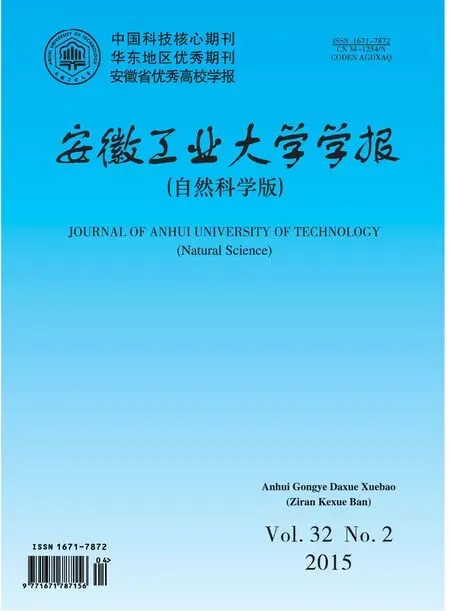AClass of Limit Theorems for DelayedAverages of Negatively Dependent Random Variables
WANG Zizhen,YAN Pengfei,HU Song,LV Wenhua
(1.School of Mathematics and Statistics,Shandong University at Weihai,Weihai 264209,China;2.School of Mathematics&Physics Science and Engineering,Anhui University of Technology,Ma'anshan 243032,China;3.School of Mathematics and Finance,Chuzhou University,Chuzhou 239000,China)
Let(an)n∈Nbe a sequence of real numbers and(kn)n∈Nbe a sequence of positive integers.The numbersare called the(forward)delayed first arithmetic means[1].The limiting properties for such delayed average have been studied by many researchers.For examples,Shepp[2]investigated some limiting properties ofρn,f(n)for mutually independent Bernoulli sequence and obtained some profound results.By using the limiting behavior of delayed average,Chow[3]found necessary and sufficient conditions for the Borel-summability of i.i.d.random variables and also obtained very simple proofs of a number of well-known results such as the Hsu-Robbins-Spitzer-Katztheorem.Lai[4]studied the analogues of the law of the iterated logarithm for delayed sums of independent random variables.
Bozorgnia,Patterson and Taylor[5]mentioned that in many stochastic models,the assumption that random variables are independent is not plausible.Increases in some random variables are often related to decreases in other random variables so an assumption of negative dependence is more appropriate than that of independence.Lehmann[6]investigated various concepts of positive and negative dependence in the bivariate case.Recently,Jian[7]and Hu[8]discussed the limit property of moving average for a class of dependent random variables.In this paper,we study analogues of the law of large numbers for delayed sums of negatively dependent random variables.We give the upper and lower bounds for delayed averages of the form(logn)for identically distributed ND(negatively dependent)r.v.'s when the moment conditionis imposed with somep>1.
1 Definitions and Propositions
Definition 1[9]A random variableXis said to be Sub-Gaussian(SG)r.v.if there exists a nonnegative real numberαsuch that for each real numbert
The number,τ(X)=will be called the Gaussian standard of the random
variableX.It is evident thatXwill be a Sub-Gaussian random variable if and only if τ(X)< ∞.Definition 2 The random variablesX1,…,Xnare said to be ND if we have
for allX1,…,Xn∈ R.An infinite sequence(Xn)n∈Nis said to be ND if every finite subsetX1,…,Xnis ND.
Proposition 1 Let(Xn)n∈Nbe mean zero ND r.v.’s with| |Xn≤dn,n>1,Then,for everyt>1,k,l∈Nwe have
Let(cn)n∈Rbe a sequence of positive real numbers,for everyn,j∈ N,denote
Proposition 2 LetX,(Xn)n∈Nbe identically distributed ND r.v.’s.Then,for everyt> 0,we have
Proposition 3 LetX,(Xn)n∈Nbe identically distributed ND r.v.’s.Then,for every ε > 0,we have
Proposition 4 LetX,(Xn)n∈Nbe identically distributed ND r.v.’s.IfEeδ|X|< ∞ ,for some δ> 0.Then for every ε>0,we have
2 Main Results and Proofs
Let(Xn)n∈Nbe a sequence be a random variables.Letγ > 0,and consider the“delayed sum”where[·]is the usual greatest integer function.
Theorem 1 Let(Xn)n∈Nbe a sequence of ND Sub-Gaussian r.v.’s with τ(Xn)≤ αn.
1)Tn,nγis a Sub-Gaussian r.v.with
3)Ifαj=α,j=1,2,…,then for some
Proof
1)By reference[10],we have
hence,Tn,nγis a Sub-Gaussian r.v.and
2)For eachε>0by reference[10],we have
3)And also
Theorem 2 Let(Xn)n∈Nbe a sequence of ND r.v.’s satisfyingP[a ≤ Xn≤ b]=1andEXn=0,for eachn,then for every
Proof
Since Xn|≤max{| a|,|b|} a.s.,hence by [10],(Xn)n∈Nis a sequence of Sub-Gaussian r.v.’s with τ(Xn)≤2((m ax{| a|,|b|})).Thus by Theorem 1,for everyβ >1/2,we have
Theorem 3 Let(Xn)n∈Nbe a sequence of ND r.v.’s withEXn=0,EXn= σ2n>0,n=1,2,…,and suppose there exists a positive constantHso that for allm≥2,
Proof
By Proposition 1,references[10-11]and Markov’s inequality for everywe have
Hence
Hence
and for eachε′>α≥ε>0,we have
Theorem 4 Let(Xn)n∈Nbe a sequence of ND r.v.’sandIf,for everyε>0,then,we have
Proof
By reference[10],and Markov’s inequality for everyε>0andt>0,we have
and by the assumption,for everyε>0,
Theorem 5 LetX,(Xn)n∈Nbe identically distributed ND r.v’s.IfEeδ|X|< ∞ for someδ>0.Then,for every ε>0,we have
Proof
Theorem 6 LetX,(Xn)n∈Nbe identically distributed ND r.v’sandc>2eEX2.Then
Proof
From(32),we have
Theorem 7 LetX,(Xn)n∈Nbe identically distributed ND r.v’s.For somep>1,letg(x)=sgnx|x|1/p.Further let t1,t2∈[0,+∞],and assume thatEetg(X)<∞fort∈(-t1,t2),Eetg(X)<∞fort∉[-t1,t2],andEX=μ .Then
and
Proof
First,we prove the following result.Lett1,t2>0be given so thatEe-t1g(X)<∞andEe-t2g(X)<∞.In particular,this impliesE|X|<∞ and,without loss of generality,we assumeEX=0.Then
It suffices to pro the inequality for the upper limit.We use the notationLx=max{1,logx}and letan=(Ln)p.Fix s2∈(0,t2),we decomposeXjintoThen
Since1≤(log(n+(logn)p)p/(logn)p→1 as n→∞,it suffices to consider onlynlarge enough that for some∈(s2,t2):
Now observe thatEX′j≤0for allj∈N,EX2<∞ andE(X2e)<∞.Note that
WhereH(x)=max{1,ex}.Which yields forj=n+1,…,n+[(logn)p]and
Hence we obtain for anyx>0:
which yields a convergent series ifSinces2∈(0,t2)was arbitrary,this proves
The same proof yields the following variant of Theorem 8:
Theorem 8 LetX,(Xn)n∈Nbe identically distributed ND r.v’s.For somep>1,letg(x)=sgnx{x}1/p.Further let γ≥1,t1,t2∈[0,+∞],and assume thatEetg(X)<∞fort∈(-t1,t2),Eetg(X)=∞fort∉[-t1,t2],andEX=μ.Then
and
[1]ZygmundA.Trigonometric Series 1[M].[S.l.]:Cambridge University Press,1959:80.
[2]Shepp LA.First passage time for a particular Gaussian process[J].TheAnnals of Mathematical Statistics,1971,42(3):946-951.
[3]Chow Y S.Delayed sums and Borelsummability of independent,identically distributed random variables[J].Bulletin of the Institute of MathematicsAcademia Sinica,1973,1(2):207-220.
[4]Lai T L.Limit Theorems for Delayed Sums[J].TheAnnals of Probability,1974,2(3):432-440.
[5]Bozorgnia A,Patterson R F,Taylor R L.Limit theorems for dependent random variables[J].Lithuanian Mathematical Journal,1974,14(4):1639-1650.
[6]Lehmann E L.Some concepts of dependence[J].TheAnnals of Mathematical Statistics,1966,37(5):1137-1153.
[7]简旭,吴玉,范爱华.关于独立同分布随机序列的若干极限定理[J].安徽工业大学学报:自然科学版,2014,31(2):209-211.
[8]胡松,汪忠志.END随机序列滑动平均的若干极限定理[J].安徽工业大学学报:自然科学版,2013,30(1):84-87.
[9]Stout W F.Almost Sure Convergence[M].[S.l.]:Academic Press,1974.
[10]Petrov V V.Limit Theorems in Probability Theory[M].[S.l.]:Oxford Science Publication,1995.
[11]Chareka P,Chareka O,Kennendy S.Locally sub-Gaussian random variables and the strong law of large numbers[J].The Atlantic Electronic Journal of Mathematics,2006(1):75-81.

